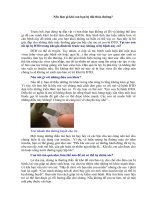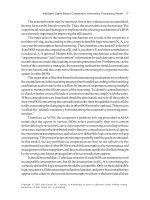Tài liệu Male Infertility Edited by Anu Bashamboo and Kenneth David McElreavey doc
Bạn đang xem bản rút gọn của tài liệu. Xem và tải ngay bản đầy đủ của tài liệu tại đây (4.15 MB, 204 trang )
MALE INFERTILITY
Edited by Anu Bashamboo
and Kenneth David McElreavey
Male Infertility
Edited by Anu Bashamboo and Kenneth David McElreavey
Published by InTech
Janeza Trdine 9, 51000 Rijeka, Croatia
Copyright © 2012 InTech
All chapters are Open Access distributed under the Creative Commons Attribution 3.0
license, which allows users to download, copy and build upon published articles even for
commercial purposes, as long as the author and publisher are properly credited, which
ensures maximum dissemination and a wider impact of our publications. After this work
has been published by InTech, authors have the right to republish it, in whole or part, in
any publication of which they are the author, and to make other personal use of the
work. Any republication, referencing or personal use of the work must explicitly identify
the original source.
As for readers, this license allows users to download, copy and build upon published
chapters even for commercial purposes, as long as the author and publisher are properly
credited, which ensures maximum dissemination and a wider impact of our publications.
Notice
Statements and opinions expressed in the chapters are these of the individual contributors
and not necessarily those of the editors or publisher. No responsibility is accepted for the
accuracy of information contained in the published chapters. The publisher assumes no
responsibility for any damage or injury to persons or property arising out of the use of any
materials, instructions, methods or ideas contained in the book.
Publishing Process Manager Martina Blecic
Technical Editor Teodora Smiljanic
Cover Designer InTech Design Team
First published April, 2012
Printed in Croatia
A free online edition of this book is available at www.intechopen.com
Additional hard copies can be obtained from
Male Infertility, Edited by Anu Bashamboo and Kenneth David McElreavey
p. cm.
ISBN 978-953-51-0562-6
Contents
Preface IX
Chapter 1 Obstructive and Non-Obstructive Azoospermia 1
Antonio Luigi Pastore, Giovanni Palleschi, Luigi Silvestri,
Antonino Leto and Antonio Carbone
Chapter 2 Gene Mutations Associated with Male Infertility 21
Kamila Kusz-Zamelczyk, Barbara Ginter-Matuszewska,
Marcin Sajek and Jadwiga Jaruzelska
Chapter 3 Apoptosis, ROS and Calcium Signaling in
Human Spermatozoa: Relationship to Infertility 51
Ignacio Bejarano, Javier Espino, Sergio D. Paredes, Águeda Ortiz,
Graciela Lozano, José Antonio Pariente, Ana B. Rodríguez
Chapter 4 The Role of PDE5 Inhibitors in the
Treatment of Testicular Dysfunction 77
Fotios Dimitriadis, Dimitrios Baltogiannis, Sotirios Koukos,
Dimitrios Giannakis, Panagiota Tsounapi, Georgios Seminis,
Motoaki Saito, Atsushi Takenaka and Nikolaos Sofikitis
Chapter 5 Effectiveness of Assisted Reproduction
Techniques as an Answer to Male Infertility 107
Sandrine Chamayou and Antonino Guglielmino
Chapter 6 Makings of the Best Spermatozoa:
Molecular Determinants of High Fertility 133
Erdogan Memili, Sule Dogan, Nelida Rodriguez-Osorio,
Xiaojun Wang, Rodrigo V. de Oliveira, Melissa C. Mason,
Aruna Govindaraju, Kamilah E. Grant, Lauren E. Belser,
Elizabeth Crate, Arlindo Moura and Abdullah Kaya
Chapter 7 A Systems Biology Approach to
Understanding Male Infertility 171
Nicola Bernabò, Mauro Mattioli and Barbara Barboni
Preface
In recent years there has been an increasing concern about possible decline in
reproductive health with an estimate of one in seven couples worldwide having
problems conceiving. Despite high and increasing rates of human infertility, our
understanding of the genetic pathways and basic molecular mechanisms involved in
gonadal development and function remains limited. A genetic contribution to
spermatogenic failure is indicated by several families with multiple infertile or
subfertile men. In some of these families an autosomal recessive mutation appears to
be responsible whilst in others an autosomal dominant mutation with sex-limited
expression is likely. In other families the genetic cause is known to involve either
chromosomal anomalies or Y chromosome microdeletions. However, only a significant
minority of the cases of male infertility and subfertility may be explained by the
genetic causes. This raises the question of environmental contribution to male
infertility and subfertility.
Prospective cross-sectional studies have indicated a general birth cohort decline in
sperm quantity and quality as well as an increase in incidence of Testicular germ cell
cancer during the last 50 years. These phenotypes, together with undescended testis
and anomalies of the male external genitalia are termed "testicular dysgenesis
syndrome” (TDS) and may have a common aetiology resulting from disruption of the
gonadal environment during fœtal life. The rapid, often synchronous, rise in the
incidence of TDS suggests an environmental aetiology possibly in genetically
susceptible individuals. Emerging data suggest that exposure of a developing male
foetus to a number of environmental factors, including but not limited to endocrine
disruptors, can negatively regulate testicular development and function. Several
studies show that this detrimental effect of environmental toxins on male germ cells
may be epigenetic resulting in aberrant DNA methylation of key genes. Several reports
suggest that the epigenetic landscape may be altered in some men with reduced sperm
counts but relationship between these changes and infertility remains unclear.
The increase in incidence of male infertility is associated with an increase in demand
for infertility treatments. These include intracytoplasmic sperm injection (ICSI) and in
vitro fertilization (IVF). In some European countries, such as Denmark, more than 6%
of children are born with assisted reproductive techniques (ARTs). There is a
suggestion that children conceived using ARTs might show a higher prevalence of
X Preface
genetic and epigenetic anomalies. This raises the question of complete molecular
characterization of sperm that will be eventually used for ARTs. Our understanding of
the molecular landscape of the sperm is likely to increase dramatically in the coming
future with the advent of new technologies that permit high throughput and detailed
molecular analysis. OMICS involving the exploration of genetic, epigenetic,
transcriptomic and proteomic modifications and their interaction with each other is
fast becoming a tool of choice to understand and interpret complex biological
phenomenon and may be used to understand key molecular events involved in the
development of the normal male germ cell lineages and their pathological
counterparts. A combination of these approaches together with strict diagnostic
criteria will increase the likelihood of success in understanding male infertility and
use of ARTs.
Dr. Anu Bashamboo
Dr. Ken McElreavey
Unit of Human Developmental Genetics
Institut Pasteur, Paris
France
1
Obstructive and Non-Obstructive Azoospermia
Antonio Luigi Pastore
1,2*
, Giovanni Palleschi
1,2
, Luigi Silvestri
1
,
Antonino Leto
1
and Antonio Carbone
1,2
1
Sapienza University of Rome, Faculty of Pharmacy and Medicine,
Department of Medico-Surgical Sciences and Biotechnologies,
Urology Unit, S. Maria Goretti Hospital Latina
2
Uroresearch Association®, Latina
Italy
1. Introduction
Azoospermia is defined as the complete absence of spermatozoa upon examination of the
semen [including capillary tube centrifugation (CTC), strictly confirmed by the absence of
spermatozoa issued in urine after ejaculation]. The presence of rare spermatozoa
(<500.000/ml) in seminal fluid after centrifugation is called "cryptozoospermia". The
complete absence of spermatozoa should be confirmed with repeat testing after a long time,
because many external factors (e.g., febrile episodes and some therapies) may cause
transient azoospermia. Azoospermia is present in approximately 1% of all men, and in
approximately 15% of infertile men. Azoospermia may result from a lack of spermatozoa
production in the testes (secretory or Non-Obstructive Azoospermia, NOA), or from an
inability of produced spermatozoa to reach the emitted semen (excretory or Obstructive
Azoospermia, OA); however, in clinical practice both components are sometimes present in
a single patient (mixed genesis azoospermia).The initial diagnosis of azoospermia is made
when no spermatozoa can be detected on high-powered microscopic examination of
centrifuged seminal fluid on at least two occasions. The World Health Organization (WHO)
Laboratory Manual for the Examination of Human Semen and Semen-Cervical Mucus Interactions
recommends that the seminal fluid be centrifuged for 15 minutes, preferably at a
centrifugation speed of ≥3000 × g.
The evaluation of a patient with azoospermia is performed to determine the etiology of the
patient’s condition. The numerous etiologies for azoospermia fall into three principal
categories: pre-testicular, testicular, and post-testicular.
1. pre-testicular azoospermia affects approximately 2% of men with azoospermia, and is
due to a hypothalamic or pituitary abnormality diagnosed with hypogonadotropic
hypogonadism;
2. testicular failure or non-obstructive azoospermia is estimated to affect from 49% to 93%
of azoospermic men. While the term testicular failure would seem to indicate a
complete absence of spermatogenesis, men with testicular failure actually have either
*
Corresponding Author
Male Infertility
2
reduced spermatogenesis [hypospermatogenesis], maturation arrest at an early or late
stage of spermatogenesis, or a complete failure of spermatogenesis (noted with Sertoli-
cell only syndrome);
3. post-testicular obstruction or retrograde ejaculation are estimated to affect from 7% to
51% of azoospermic men. In these cases, spermatogenesis is normal even though the
semen lacks spermatozoa.
Diagnosis
The minimum initial evaluation of an azoospermic patient should include a complete
medical history, physical examination, and hormone level measurements. Relevant history
should investigate prior fertility; childhood illnesses such as orchitis or cryptorchidism;
genital trauma or prior pelvic/inguinal surgery; infections; gonadotoxin exposure, such as
prior radiation therapy/chemotherapy and current medical therapy; and a familial history
of birth defects, mental retardation, reproductive failure, or cystic fibrosis. Physical
examination includes: testis size and consistency; consistency of the epididymides;
secondary sex characteristics; presence and consistency of the vasa deferentia; presence of a
varicocele; and masses upon digital rectal examination. The initial hormonal evaluation
should include measurement of serum testosterone (T) and follicle stimulating hormone
(FSH) levels.
History and initial investigations for men with azoospermia
Cryptorchidism: the bilateral form is almost always associated with azoospermia and
irreversible gonadal secretory dysfunction. The age at which surgical intervention is
practiced and subsequent gonadal development may sometimes affect the prognosis. In
addition, not infrequently, germinal malformations are also associated with atrophy of the
epydidimus and sometimes with iatrogenic damage to the vas deferens. In unilateral
cryptorchidism, azoospermia is less frequent; azoospermia in a patient with unilateral
cryptorchidism is likely the result of concurrent secretory dysfunction (dysgenesis) or other
pathology of the contralateral testis.
Reduced volume of ejaculate: occurs progressively in the post-inflammatory obstruction of
the ejaculatory ducts (ED), with a concomitant reduction of seminal fructose and lowering of
pH. Ejaculate volume is normally reduced in cases of vas deferens agenesis or in the
presence of large seminal cysts (Müllerian or Wolffian). The same phenomenon is present in
primary hypogonadism. Partial retrograde ejaculation is present in patients with systemic
neuropathy (e.g., juvenile diabetes and multiple sclerosis), and is a possible outcome of
endoscopic urological surgery for bladder neck sclerosis.
Urological symptoms and signs: the clinician must always pay close attention to symptoms,
even prior symptoms that may previously have had no apparent significance, such as
episodes of hemospermia, burning urination, urinary frequency, and urethral
catheterization after surgery. All of these symptoms should raise the suspicion that the
proximal or distal seminal tract may be obstructed (Silber, 1981). The presence of
hypospadias may be associated with urinary abnormalities, hypogonadism, cryptorchidism,
and the presence of residues in the Müllerian duct of the prostate (utricular cysts). These
cysts can be responsible for extrinsic compression of the ED.
Obstructive and Non-Obstructive Azoospermia
3
Surgery: Inguinal hernioplasty interventions (often performed during infancy) may have
damaged the tubes, and then create a condition of seminal tract obstruction. Resection of the
funicular vessels may result in hypotrophy of the gonad.
Family history: Clinicians should be attentive to the concomitant presence of infertility in
the patient’s male relatives (as a result of chromosomal abnormalities, genetic conditions,
tuberculosis, etc.). Scrotal traumas are often responsible for complete or incomplete
epididymis obstruction, as well as trophic changes of the gonad.
Prior chemotherapy and radiotherapy: Drug and radiation treatments for tumors usually
cause irreversible damage to spermatogenesis. Even high-dose hormone therapy; antibiotic
therapy with tetracyclines, nitrofurans, and sulfasalazine; or other drug therapies often
temporarily alter spermatogenesis.
Chronic obstructive pulmonary diseases are frequently associated with obstruction of the
epididymis (11-21%). This condition is often the result of primary ciliary dyskinesia (also
known as Kartagener Syndrome) or cystic fibrosis, the latter often characterized by agenesis
of the distal epididymis, vas deferens, and seminal vesicles. The most common cause of
congenital bilateral absence of the vas deferens (CBAVD) is a mutation of the cystic fibrosis
trans-membrane conductance regulator (CFTR) gene. Almost all males with clinical cystic
fibrosis have CBAVD, and approximately 70% of men with CBAVD and no clinical evidence
of cystic fibrosis have an identifiable abnormality of the CFTR gene.
The CFTR gene is extremely large and known mutations in the gene are extremely
numerous. Clinical laboratories typically test for the 30–50 most common mutations found
in patients with clinical cystic fibrosis. However, the mutations associated with CBAVD may
be different. Because over 1,300 different mutations have been identified in this gene, this
type of limited analysis is only informative if a mutation is found. A negative test result only
indicates that the CBAVD patient does not have the most common mutations causing cystic
fibrosis. Testing for abnormalities in the CFTR should include, at minimum, a panel of
common point mutations and the 5T allele. There is currently no consensus on the minimum
number of mutations that should be tested.
Bilateral testicular atrophy may be caused by either primary or secondary testicular failure.
Elevated serum FSH associated with either normal or low serum testosterone is consistent
with primary testicular failure. All patients with these findings should be offered genetic
testing for chromosomal abnormalities and Y-chromosome microdeletions. Low serum FSH
associated with bilaterally small testes and low serum testosterone is consistent with
hypogonadotropic hypogonadism (secondary testicular failure). These patients usually also
have low serum luteinizing hormone (LH) levels. Hypogonadotropic hypogonadism can be
caused by hypothalamic disorders (e.g., functioning and non-functioning pituitary tumors).
Therefore, these patients should undergo further evaluation, including serum prolactin
measurement and imaging of the pituitary gland.
When the vasa deferentia and testes are palpably normal, semen volume and serum FSH are
key factors in determining the etiology of azoospermia. Azoospermic patients with normal
ejaculate volume may have reproductive system obstruction or spermatogenesis
abnormalities. Azoospermic patients with low semen volume and normal-sized testes may
have ejaculatory dysfunction or ejaculatory duct obstruction (EDO).
Male Infertility
4
Normal semen volume
The serum FSH level of a patient with normal semen volume is a critical factor with which
to establish whether a diagnostic testicular biopsy is needed to investigate spermatogenesis.
Although a diagnostic testicular biopsy will determine whether spermatogenesis is
impaired, it does not provide accurate prognostic information regarding whether or not
sperm will be found on future sperm retrieval attempts for patients with NOA. Therefore, a
testicular biopsy is not necessary to establish the diagnosis or to provide clinically useful
prognostic information for patients with consistent clinical findings for the diagnosis of
NOA (e.g., testicular atrophy or markedly elevated FSH). Conversely, patients who have a
normal serum FSH should undergo a diagnostic testicular biopsy, because normal or
borderline elevated serum FSH levels may suggest either obstruction or abnormal
spermatogenesis. If the testicular biopsy is normal, an obstruction in the reproductive
system must be found. Most men with OA, palpable vasa deferentia, and no history of
iatrogenic vasal injury present with bilateral epididymal obstruction. Epididymal
obstruction can be identified only by surgical exploration. Vasography may be utilized to
determine whether there is an obstruction in the vas deferens or ED.
Reduced semen volume
Low ejaculate volume (< 1.0 ml) that is not caused by hypogonadism or CBAVD may be
caused by ejaculatory dysfunction, but is most likely caused by EDO. Ejaculatory
dysfunction rarely causes low ejaculate volume with azoospermia, although it is a well-
known cause of aspermia or low ejaculate volume with oligozoospermia. Additional
seminal parameters that may be helpful in determining the presence of EDO are seminal pH
and fructose, since the seminal vesicle secretions are alkaline and contain fructose. EDO is
detected by transrectal ultrasonography (TRUS). The finding of midline cysts, dilated ED,
and/or dilated seminal vesicles (>1.5 cm in antero-posterior diameter) on TRUS is
suggestive, but not diagnostic, of EDO. Therefore, seminal vesicle aspiration (SVA) and
seminal vesiculography may be performed under TRUS guidance to make a more definitive
diagnosis of EDO. The presence of large numbers of sperm in the seminal vesicle of an
azoospermic patient is highly suggestive of EDO. Seminal vesiculography performed
contemporary with SVA can localize the site of obstruction. EDO is detected by TRUS, and
is usually accompanied by dilation of the seminal vesicles (typically >1.5 cm).
Fig. 1. Ultarsound Investigation: Intraprostatic cyst with ejaculatory duct obstruction
Obstructive and Non-Obstructive Azoospermia
5
Genetic investigations for men with azoospermia
All men with hypogonadotropic hypogonadism should be referred for genetics counseling,
as almost all of the congenital abnormalities of the hypothalamus are due to a genetic
alteration.
If a genetic alteration is identified, then genetic counseling is suggested (Level of evidence 2,
Grade B recommendation). In addition to mutations in the CFTR gene that give rise to
CBAVD, genetic factors may play a role in NOA. The two most common categories of
genetic factors are chromosomal abnormalities resulting in impaired testicular function, and
Y-chromosome microdeletions leading to isolated spermatogenic impairment.
Chromosomal abnormalities account for approximately 6% of all male infertility, and the
prevalence increases with increased spermatogenic impairment (severe oligospermia and
NOA).
Approximately 13% of men with NOA or severe oligospermia may have an underlying Y-
chromosome microdeletion. Y chromosome microdeletions responsible for infertility —
azoospermia factor (AZF) regions a, b, or c — are detected using sequence-tagged sites (STS)
and polymerase chain reaction (PCR) analysis. Y chromosome microdeletions carry both
prognostic significance for finding sperm, and consequences for offspring if these sperm are
utilized. Although successful testicular sperm extraction has not been reported in infertile
men with large deletions involving AZFa or AZFb regions, the total number of reports is
limited. However, up to 80% of men with AZFc deletions may have retrievable sperm for
intracytoplasmic sperm injection (ICSI).
Treatments for azoospermia
Obstructive azoospermia
Instrumental and surgical treatments designed to restore natural fertility
1. Microsurgical recanalization of the proximal seminal tract
a. Obstruction of the epididymis: epididymal tubal vasostomy (vasoepididymostomy)
b. Obstruction of the vas deferens: vasovasostomy
2. Recanalization of the distal seminal tract
a. Transurethral resection of the ejaculatory ducts (TURED)
b. Transrectal ultrasound-guided by unblocking (TRUC)
c. Seminal tract washout treatment
3. Surgical or instrumental sperm collection for artificial reproductive treatment
- Testis
a. Testicular sperm extraction (TESE)
b. Testicular sperm aspiration (TESA)
c. Testicular fine needle aspiration (TEFNA)
- Epididymis
a. Microsurgical epididymal sperm aspiration (MESA)
b. Percutaneous epididymal sperm aspiration (PESA)
c. Epididymal sperm extraction (ESE)
- Vas deferens and distal seminal tract
a. Microscopic vasal sperm aspiration (MVSA)
Male Infertility
6
b. Distal seminal tract aspiration (DISTA)
c. Transrectal ultrasound-guided aspiration of sperm from intraprostatic cysts
communicating with the ED
d. Seminal tract washout designed to recover sperm for in vitro fertilization (IVF)
Secretory azoospermia
a. Medical treatment
b. The varicocele in azoospermia
c. Surgical removal of sperm from the testicle or instrument for artificial insemination
1. Testicular sperm extraction (TESE)
2. Testicular sperm aspiration (TESA) and Testicular fine needle aspiration (TEFNA)
Retrograde ejaculation
a. Pharmacotherapy
b. Recovery of sperm from the urine as an aid to artificial insemination
Anejaculation
a. Etiologic treatments
b. Treatment aimed to recover sperm for assisted reproductive technology (ART)
1. Vibratory ED massage
2. Electroejaculation
3. Seminal tract washout designed to recover sperm for IVF or cryopreservation of
testicular sperm
Obstructive azoospermia
The aim of treating obstructive azoospermia is to restore the patency of the seminal tract
and spontaneous fertility. Treatment choice depends on the localization and characteristics
of the obstructing lesion. When it is not possible to restore the patency of the seminal tract,
the next step is to proceed to surgical sperm recovery (to be used fresh or after
cryopreservation for ART).
2. Microsurgery: Reconstruction of the proximal seminal tract
The correct implementation and results of microsurgical reconstruction of the proximal
seminal tract depend upon the use of special instruments (surgical microscope), non-
reactive suture materials, and the technical skill of the operator. The surgical microscope is
essential to evaluate the quantity and quality of sperm during seminal fluid aspiration. This
determination dictates the choice of reconstructive surgery.
Surgery is indicated in the following cases:
- Azoospermia confirmed by at least two recent seminal examinations
- Preservation of spermatogenesis on at least one side
- Absence of retrograde ejaculation
- Absence of seminal tract infection
The reconstruction of the seminal tract is still subject to its proximal distal patency, which is
demonstrated in the phase immediately preceding reconstructive surgery through
Obstructive and Non-Obstructive Azoospermia
7
cannulation of the deferent (butterfly needle 23-25 Gauge) and injection of at least 10 ml of
saline solution.
Epididymal obstructions: Vasoepididymostomy
Vasoepididymostomy is performed to treat congenital, infectious, post-vasectomy or
idiopathic obstruction of the epididymis. The rate of restoration of patency varies between
60% and 87%, and spontaneous pregnancies vary between 10% and 43%.5-8 Accuracy
of microsurgical technique affects the outcome of reconstructive procedures on
the male reproductive system. The best results are achieved by surgeons with training
and ongoing experience in microsurgery. To maximize successful outcomes, surgeons
performing vasectomy reversal should be comfortable with anastomoses involving
extremely small luminal diameters, and must be competent with both vasovasostomy
and vasoepididymostomy, because the latter may be unexpectedly necessary in many
cases.
Before vasoepididymostomy, or when anastomosis is not feasible, sperm aspiration and
cryopreservation should be performed for future use for ICSI, in case of failure of the
anastomosis. In some cases, the reappearance of sperm in the seminal liquid happens more
than one year after surgery. Stricture of the anastomosis has been observed after some time,
at rates varying between 10% and 21%. The absence of sperm in the epididymal tubule or
the presence of diffuse fibrosis of the organ are two negative prognostic factors that indicate
the presence of a secretory testicular pathology. The presence of ultrasound abnormalities of
the distal seminal tract have recently been reported as adverse prognostic factors for the
success rates of recanalization. Vasoepididymostomy in patients with obstruction secondary
to vasectomy is more advantageous in terms of costs compared with MESA with ICSI
pregnancies.
Technical notes
The epididymis is opened where there is a clear tubular dilation due to the obstacle;
however, the opening should be as caudal as possible. The liquid that issues from the
epididymis is immediately examined to assess the presence and motility of sperm. If the
determination is negative, a more proximal tubule will be opened. If the goal is to make
an end-to-end vasostomy, after transverse incision of the epididymis tunica vaginalis, the
section of the seminal tubules containing sperm should be chosen to perform the
anastomosis with the deferent to reduce the possibility of developing strictures in the
future. A latero-terminal vasostomy appears to avoid this eventuality without additional
effort. Under optical magnification of the field (40×) (the center of a window previously
prepared in the tunica vaginalis of the epididymis), a loop is opened longitudinally and
the tubulus is anastomosed to deferent with two stitches (8-0 Prolene). To prevent leakage
of seminal fluid and the resulting formation of granulomas, the stitches should be as
superficial as possible and at the end it is recommended that fibrin glue be placed on the
anastomosis.
Obstructions of the vas deferens: Vasovasostomy
The obstruction of the vas deferens that results from vasectomy or, more rarely, from an
incorrect vesiculodeferentography, can usually be successfully treated. By contrast, in
Male Infertility
8
Fig. 2. Vasoepididymostomy
lesions of the distal vas deferens, usually resulting in bilateral herniorrhaphy, the stumps of
the vas deferens are often poorly identified in the context of scar tissue. It is therefore
necessary to resort to a wide mobilization of the stumps to perform both proximal and distal
anastomosis. The outer diameter of the duct remains constant as a result of obstruction,
while the inner testicular slope expands approximately 2-4 times. Distal stump sclerosis may
progress to scarring. Factors that will influence the success of the anastomosis are:
- The use of a surgical microscope
- The quality of the tissues involved in the anastomosis
- The presence and characteristics of the fluid that is released from the proximal stump of
the ductus
- Distal patency of the seminal vesicle
- The duration of obstruction
The recanalization rates extrapolated from the main series (a total of 2385 cases treated) vary
between 86% and 93%, while the cumulative spontaneous pregnancy rates range between
52% and 82%. The duration of the obstruction appreciably affect the success rate of
vasovasostomy. When the interval between obstruction and recanalization is shorter than 3
years, patency and spontaneous pregnancies are obtained, respectively, in 97% and 76% of
cases, compared with 88% and 53% when the interval is between 3 and 8 years, and 71% and
30% when the interval is between 9 and 14 years. Deferential distal obstructions are often
incorrigible. In these cases, the aspiration of sperm from the proximal deferential stump
may be used or, if there is a concomitant epididymal obstruction, MESA or TESE may be
employed (see related chapters).
Technical Notes
Reconstruction of the deferent can be performed in "double layer" or "single layer". In two-
layer vasovasostomy, the mucous layer and inner muscle of the two stumps are sutured
Obstructive and Non-Obstructive Azoospermia
9
with 6 sutures (preferably non-absorbable or slow resorption 9/0-10/0); then, the outer
muscular and serosal layers are secured with 6 sutures 8/0-9/0, interspersed with the first.
However, the sutures pass through the wall of the deferent at ≥6 points, possibly full-
thickness.
Fig. 3. Vaso-vasostomia
3. Recanalization of the distal seminal tract
Transurethral resection of the ejaculatory ducts (TURED)
Transurethral resection of the ejaculatory ducts (TURED) was proposed in 1973 by Farley
and Barnes for the resolution of (EDO). Since then, several studies have documented its
effectiveness. The term also includes the endoscopic resection of the ED obstructing
prostatic cysts, even if improperly, because in this case the ED are not properly resected, but
only the anterior wall of the cyst, making it widely communicate with the prostatic urethra.
The indications for TURED are represented by a complete or incomplete congenital or
acquired obstruction of the distal seminal tract, caused by atresia, strictures, or scarring; or
in the presence of gallstones of ED; or subsequent prostatic cysts, whether or not they
communicate with the seminal tract. Only issues relating to the use of TURED in cases of
azoospermia will be taken into account.
Until a few years ago, TURED was the only therapeutic option in cases of obstruction of ED.
Recently, successful sperm retrieval techniques for assisted reproduction (e.g., ICSI) and the
introduction of new techniques (ultrasound-guided sclerotherapy of prostatic cysts, Seminal
Tract Wash-out) have reduced its use. Nevertheless, TURED must still be considered an
effective therapeutic method that allows patients to obtain natural pregnancies in a
significant percentage of cases of obstructive azoospermia. A recent review of 164 cases
reported in the literature documented a recanalization rate of 36% and a pregnancy rate of
26%. Regarding cystic obstruction of the ED, TURED could be used in the seminal cysts
communicating with the seminal tract. In the presence of non-communicating cysts
(Müllerian or median), transrectal ultrasound-guided or percutaneous sclerotherapy are first
indicated, and only in case of their failure should TURED be performed.
Male Infertility
10
Fig. 4. TURED
Transrectal ultrasonically guided aspiration (TRUCA) of the seminal distal tract
Transrectal ultrasonically guided cyst aspiration (TRUCA) is a minimally invasive
technique, suitable to evacuate intraprostatic cysts that are making an extrinsic compression
on the ED. The above are of Müllerian cysts that do not communicate with the ED and do
not contain sperm. The aspiration of the cyst temporarily or permanently restores normal
patency of the ED. This procedure is used as an alternative to endoscopic transurethral
incision of the Müllerian cysts.
Technical notes
A transrectal probe of 6.5-7.5 MHz biplanar is used to perform this technique, with a 20-22 G
Chiba needle guide connected to a 5 ml syringe for suction. The treatment is conducted with
the patient placed on his left side, after oral antibiotic coverage The aspiration is performed
with after the patient had abstained from sex from 4 to 5 days to determine the chemical-
physical characteristics of the aspirated fluid and the presence of sperm. Shortly after
aspiration, the patient is requested to provide a semen sample for analysis. Immediately
after, the clinician should recheck the cyst to assess its possible immediate filling (in this
case, the cyst is communicating with the seminal tract, and therefore should not be
inflexible). For sclerotherapy, an antibiotic (tetracycline) is instilled into the cyst at a rate of
one-tenth of the previously aspirated volume. This procedure allows recovery of patency of
the distal seminal tract in 75% of patients.
Seminal tract washout therapy aims to restore the patency of the ejaculatory ducts
Seminal Tract Washout (STW) therapy is indicated in azoospermic patients in whom an
ultrasound of the distal seminal tract (controlled before and after ejaculation) documents
obstruction of the orifices of the ED.1 This framework is characterized by an expansion of
products that are associated with dilation of the seminal vesicles throughout their course,
Obstructive and Non-Obstructive Azoospermia
11
Fig. 5. TRUCA
possibly with seminal calcifications within them. STW is not indicated in patients with a
transrectal ultrasound examination that clearly shows a post-inflammatory obstruction of
the ED. The STW runs with the same methods described for the STW designed to retrieve
sperm for use in assisted reproduction. The unblocking of the orifice of the ED does not rule
out the option of recovering and cryopreserving the sperm present in the seminal tract
obstruction.
4. Surgical or instrumental sperm collection for artificial insemination
Testicular Sperm Extraction (TESE)
TESE is the extraction of sperm from testicular parenchymal fragments obtained from single
or multiple surgical biopsies. TESE was initially introduced by Silber et al. in 1995, as a
method of sperm retrieval for ICSI in cases of azoospermia.
TESE is one of several options for sperm retrieval in cases of OA, with directions more or
less similar to other techniques. As a testicular removal, it has the advantage over
epididymal sperm extraction (ESE) of not obstructing the patency of the epididymis tubule.
This advantage can be especially important in cases of potentially reconstructible proximal
obstructions (which remain the only curative option in reconstructive surgery), particularly
those involving cases of distal ejaculation or anejaculation. Compared with epididymal
microsurgical sperm aspiration (MESA), TESE permits the recovery of sperm, and is
definitely easier because it does not require the use of a surgical microscope. TESE could be
considered the ideal solution to retrieve sperm in those rare cases in which obstructive
MESA fails, during the same surgical procedure. TESE is slightly more invasive and
complex than the percutaneous techniques; however, in comparison TESE allows the
recovery of a more appropriate number of sperm (almost always enough to freeze and use
in subsequent cycles of ICSI). Several authors have proposed using TESE directly with
cryopreservation in the course of diagnostic testicular biopsy.
Male Infertility
12
(a)
(b)
Fig. 6. (a) TESE, (b) TESA
Epididymal Microsurgical Sperm Aspiration (MESA)
MESA was the first sperm retrieval technique used for ART (Silber, 1987). While it was
initially associated with IVF, since 1994 MESA has usually been associated with ICSI, even
though the use of IVF may still be justified when sperm of good quality and quantity is
recovered. MESA allows better recovery in terms of quantity and quality of sperm. Thanks
to microsurgical techniques, it is possible to minimize blood contamination and choose the
tubules with the best features for good sperm recovery.13 The chances of sperm retrieval
with MESA are >95%, and it is almost always possible to freeze a sufficient number of
sperm for any subsequent cycles of ICSI. Therefore, the male partner is usually subjected to
a single intervention. The disadvantages of MESA arise because it is a complex technique
that requires a manual microsurgical, as well as the availability of an operating microscope
and proper instrumentation. The time and costs of MESA intervention are therefore higher
than other techniques. MESA is now performed under local anesthesia with the patient's
Obstructive and Non-Obstructive Azoospermia
13
immediate resignation. Normally it is sufficient to intervention only in cases of unilateral
and insufficient sperm retrieval.
Technical notes
Traditional technique: General anesthesia, or local infiltration of the umbilical cord and the
scrotal skin with any anesthesia care or sedation. A median scrotal incision is made with the
opening of the tunica vaginalis and externalization of the testis. Under 20-30× magnification,
a slot is removed from the head of the epididymis tunica albuginea and hemostasis is
ensured with a bipolar forceps jeweler. The clinician then opens the tubule with
microscissors and aspirates the liquid with a 22 or 23 G cannula mounted on an insulin
syringe. Slight pressure on the testis and epididymis promotes the release of sperm. The
extraction is continued with several syringes until leakage occurs, or until the biologist who
monitors the sample finds it sufficient for freezing. Closure of the tubule with a 10/0 stitch
is optional. In the variant proposed by Schlegel, instead of opening the tubule with
microscissors, the tubule is pricked with a specially prepared, sharp glass micropipette
connected to a suction system. This alternative saves time spent searching for the area with
better sperm quality and minimizes blood contamination.
Mini-MESA: In this variation of the technique, an incision is made approximately 1 cm from
the window as a diagnostic testicular biopsy. Instead of exteriorizing the testicle, only the
head of the epididymis is dislocated from the incision and secured with a stitch on the edge
of the same. The technique then continues in the same way as the traditional technique,
using a surgical microscope for subsequent phases of sperm aspiration from the epididymal
tubules. Advantages of this alternative technique include the lack of externalization of the
testis, reduction of pain experienced by the patient, and a minimized possibility of
postoperative surgical adhesions.
(a) (b)
Fig. 7. (a) MESA, (b) Mini MESA
Epididymal Percutaneous Sperm Aspiration (PESA)
Introduced by Craft in 1995, PESA represented the first "economic" alternative to MESA in
patients with OA. Like TESA, PESA has the advantages of being easily implemented,
Male Infertility
14
economical, and minimally invasive. The main limitation of PESA is its lower efficacy
compared with MESA sperm retrieval. In several studies, PESA seems to allow sperm
recovery in approximately 60-70% of OA cases, compared with a 90-95% sperm recovery
rate by MESA. The lower sperm recovery rate of PESA is presumably a consequence of the
particular anatomic situation of the tubules of the head of the epididymis, which, when
obstructed, are not uniformly dilated and do not contain the same amount or quality of
sperm. If in the course of MESA is possible to drive on the intake and more dilated tubules
with more chance of recovering motile sperm, PESA may just sting tubules without sperm
or with sperm of poorer quality. Because PESA results in aspirated sperm of lower quantity
and poorer quality, the possibility of freezing sperm for subsequent ICSI cycles is
significantly lower with PESA than with MESA. By contrast, compared with TESA, PESA
may allow better sperm retrieval, with less contamination from blood or other parenchymal
cells. However, PESA involves an increased risk of scrotal hematoma than TESA, caused by
the greater vascularity of the area of the head of the epididymis. PESA represents the
technique of choice in cases of obstruction or congenital or acquired spermatocele in the
epididymis. In this situation, PESA allows easy retrieval of a large amount of sperm with
minimal invasiveness, and can be performed without any anesthesia.
Technical Notes
Regarding the need for anesthesia, the same considerations apply to PESA as to TESA.
When aspirating, it is best to use a butterfly needle (21 or 22 G) connected to a 20-ml or
50-ml syringe. Aspiration should be applied to only the head of the epididymis, not to the
body or tail. The clinician should immobilize the head of the epididymis by holding it
between thumb and forefinger, and insert the needle into it. With the syringe, and always
under slight suction, advance or retract the needle millimeter-wise until a small amount of
clear liquid is observed in the connecting pipe. Continue suction until the flow stops. In
most cases, this technique will result in a small quantity of well-aspirated sperm. The
aspirated fluid is then diluted in culture medium and examined for sperm. If no sperm is
recovered, the clinician should proceed to other aspirations, trying to puncture different
parts of the head of the epididymis. It may help to exert pressure on the head of the
epididymis for a few minutes, and to keep a bag of ice on the scrotum to minimize the risk
of bleeding.
Fig. 8. PESA
Obstructive and Non-Obstructive Azoospermia
15
5. Epididymis
Epididymal Sperm Extraction (ESE)
ESE is the surgical removal (no need for microsurgical techniques) of more or less
substantial portions of the head of the epididymis for sperm extraction. ESE was described
for the first time by Kim, although it had already been used sporadically by many clinicians.
The extraction technique is identical to TESE. ESE has the advantage of being very fast, does
not require the use of a surgical microscope, often provides excellent recoveries that are
almost always sufficient to freeze sperm, and is associated with fertilization and pregnancy
rates similar to those associated with other techniques. Its main disadvantages are that it is
more invasive; the removal or parts of the epididymis is less repeatable (to be performed
only in intractable situations of obstruction, such as CBAVD or congenital bilateral agenesis
of the vasa deferentia); a higher risk of vascular damage to the testis; and increased blood
contamination of the fragment to be treated. ESE is a viable option, and is therefore often
used in the course of MESA, when it is not possible to retrieve sperm microaspirates from
any of the epididymal sites.
Technical Notes
ESE can be performed under regional anesthesia or sedation. A medial scrotal incision is
made, through which the testicle (or simply the head of the epididymis) is exteriorized.
With scissors, the surgeon separates it from the testis to approximately 5 mm, dissecting
some of the efferent vessels. The surgeon then uses scissors or a scalpel to cut a portion of
the epididymis, and the entire head is immersed in a cell culture dish. Next, the biologist
will perform the fragmentation of the piece first with scissors or scalpel and then slides with
two sterile insulin needles.
Surgical or instrumental collection of sperm for assisted fertilization:
The vas deferens and distal seminal tract
Microscopic Vasal Sperm Aspiration (MVSA)
MVSA consists of the microsurgical aspiration of sperm from the lumen of the deferent. It is
indicated in cases of distal deferential obstruction without any possibility of surgical
reconstruction (e.g., iatrogenic damage from pelvic surgery or hernioplasty); cases of EDO;
cases in which TURED or other techniques cannot be used to harvest sperm (e.g., DISTA); in
cases of retrograde ejaculation with insufficient sperm retrieval from the post-orgasm urine;
in cases of anejaculation due to different causes; or when vibrostimulation or
electroejaculation fail. Finally, MVSA is indicated in selected cases of necrozoospermia or
pronounced oligoastenozoospermia in the presence of structural or functional disorders of
the emptying of the distal seminal tract that result in prolonged stagnation of the sperm. In
these patients, sperm can be obtained from the deferent with good motility and vitality. The
recovery of sperm cells that almost always exhibit very good motility makes it possible to
opt for less invasive ART techniques (e.g., IVF, intrauterine insemination), as well as
freezing. The main disadvantage of MVSA is that the procedure must be performed using
microsurgical technique, which is essential for the closure of the rubble of the deferent
because of the risk of iatrogenic obstruction.









